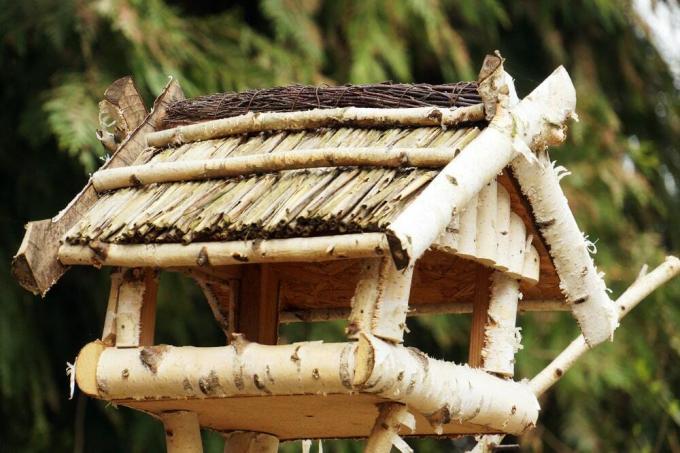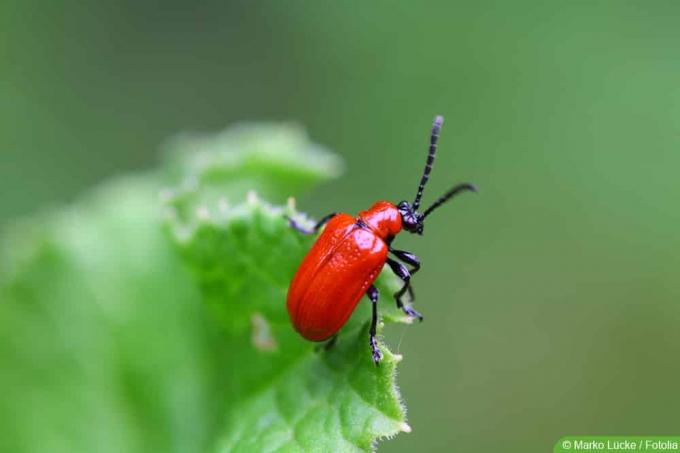

Table of contents
- Recognize the apple spider moth
- Damage to the apple tree
- Combat: the right time
- crop protection products
- cutting measures
- parasite insert
- When countermeasures do not make sense
- promote beneficials
The apple spider moth is just one representative of the spider or bud moths. The butterflies, which belong to the moths, are mostly unknown. However, they get the gardener's full attention when they cover an entire apple tree with a fine white web and eat it bare. Concern about the apple tree is usually unfounded, but fighting the cobwebs can be advisable.
Recognize the apple spider moth
The moth belongs to the moth family and is rarely perceived as such by humans. The butterfly is small and inconspicuous, white in color with black dots. Even individual caterpillars of the spider moth are not noticeable, they are also small, yellowish-brown and have the characteristic black dots. Finally, what finally attracts the gardener's attention are the white webs in infested trees, which can assume very large proportions. By the time it gets that far, however, the cobwebs have already done some damage. The female butterfly lays the eggs the year before and the larvae overwinter in a secure cocoon. They begin their feeding activity in the spring of the new year.
Damage to the apple tree
In the beginning there is almost nothing to see of the activities of the small larvae, especially when it comes to larger trees. At first, the cobwebs eat inside the leaves and are therefore not visible. After a short time, however, they begin to eat the leaves themselves and weave them together with ever larger webs. Within these webs, the caterpillars can be clearly seen while they are feeding. Depending on how many larvae are in the apple tree, the entire tree can eventually be covered in fine white webs and eaten completely bare. The tree looks dead at this point.
Combat: the right time
With all measures, it is important to apply them at the right time, otherwise they will be ineffective. In the case of the spider moth, however, this period is when the infestation is hardly noticeable and the gardener may not yet know that the spider caterpillars are in the tree. Once the moth larvae have spun themselves in, combating them is difficult and works best with mechanical means.
In order to be able to intervene early, it can be advantageous to check the cut branches for the clutches of the apple spider moth when pruning fruit trees in winter. These are on perennial shoots and are brownish colored cocoons. Inside there are different numbers of eggs.
Once the infestation has been identified with certainty, there are several ways to combat it. This includes:
- crop protection products
- Cut out the affected areas
- parasite insert
crop protection products
Insecticides can kill the larvae in the tree. They can be used preventively in the spring when clutches of the apple spider moth have been found in the tree in winter or when the first infestation becomes visible. Once it is certain that the webs are large, it is no longer worth spraying insecticides, as the moth larvae cannot reach them. Another disadvantage of crop protection products is that they are not selective. They also kill harmless insects. Even agents based on a bacterium, which is only dangerous to butterflies, kill not only the larvae of the apple spider moth but also caterpillars of other butterfly species.

Tip:
Insecticides should be avoided in the garden wherever possible. Methods that do no harm to other species are always preferable.
cutting measures
The infestation can be combated well with a pruning, but it must be remembered that parts of the crown of the tree have to be sacrificed. Affected shoots are cut out together with the webs with garden shears. A pruning shears is necessary for larger infestations, even if thicker branches are spun in. This measure is also worthwhile once the larvae have pupated. With this, almost all moth caterpillars and pupae can be removed from the tree.
However, it is necessary to collect all clippings from the garden and dispose of them in the garbage or at a public composting facility. The ground around the tree in question should also be checked for fallen webs or pupae. With early pruning measures, other insects and butterflies are spared and at least part of the yield can be saved.
parasite insert
The use of parasites to combat harmful insects is relatively new. However, since it is a purely biological measure, it is becoming more and more fashionable. Almost all butterfly species are parasitized by other insects. The infection usually occurs in the egg or in the young caterpillar. These are eaten up from the inside by the parasite and can no longer develop into a finished butterfly. Reproduction is interrupted.
Parasites on butterflies:
- parasitic wasps
- chalcids
- flesh flies
- caterpillar flies
Parasites can be obtained from appropriate providers. How they are used is explained in the respective instructions. Depending on the amount used, the success can be very good. There is no need to be afraid of the hatching wasps, as they are solitary species that do not have much in common with the common wasp and are therefore not a nuisance in the garden. Instead, one can assume that the adult parasitic wasps look for new "victims" for further reproduction and thus keep other caterpillar species in the garden in check.
When countermeasures do not make sense
If it cannot be overlooked that the entire tree is affected, fighting is no longer worthwhile. In this case, the only thing that helps is to wait until the spook is over and the tree sprout again. The webs, whether with or without caterpillars and pupae, can be removed from the tree with sticks. A hard jet of water from the garden hose can also help. Webs, larvae and pupae are collected and destroyed. Glue rings are placed around the tree trunk and any support posts to prevent overlooked mothworms from crawling back into the tree. Otherwise, however, glue rings are useless for combating the apple spider moth, since the moths fly and the caterpillars do not leave the tree.
promote beneficials

In order to prevent the infestation or at least to prevent it from taking on large proportions, preventive measures are helpful. The most important thing is to promote the biological balance in the garden, so that pests and beneficial insects are balanced. Many species of songbirds are predators of butterflies and their larvae. These can be settled in the garden with the following options:
- offer nesting facilities and nesting material
- water point
- feeding place
- natural corners in the garden with many hiding places
- Protective measures against predators such as cats
Regular pruning in winter is also a preventive measure. This removes part of any scrims from the tree.
Tip:
It can be helpful to keep chickens in the orchard, provided there are opportunities to do so. Chickens will eat caterpillars and their pupae and other pests that can get into the tree via the ground.
 garden editorial
garden editorial I write about everything that interests me in my garden.
Learn more about plant pests

White spots on leaves: what to do?
Whether in the home or in the garden, white spots on the leaves of your favorite plants are always a cause for concern. However, the causes can often be eliminated quickly. This guide summarizes the most common triggers and gives tips for quick help.

Cherry laurel has yellow eaten leaves: what to do?
Despite the robust nature of Prunus laurocerasus, it is occasionally attacked by pests and fungi. An infestation can be recognized by feeding damage and the discoloration of the leaves to yellow. You can find out how to combat and prevent the accumulation here.

Fighting grubs | Protect raised bed & lawn
Larvae of various species of beetles, grubs, can do a lot of damage in the garden. They live in the ground for several years and prefer to feed on roots. We present effective methods to combat the voracious pest or to effectively prevent an infestation.

Worms in cherries - 8 tips against maggots in cherries?
Worms in sweet cherries can spoil your appetite. It is a major nuisance when the entire cherry crop is affected. With these tricks you can contain the pest infestation and ensure that the insects do not multiply any further.

Fighting lily beetle - 11 effective home remedies
Lilies in the garden are beautiful to look at. There are the greatest types and varieties, all of which somehow have something special. Lily lovers can draw from the abundance of offers and look forward to the floral splendor. Lilies are actually quite hardy. There are few diseases and pests that can cause damage. However, the lily chicken can spoil the splendor.

Combating fungal infestation on trees: how to remove tree fungi
A tree fungus does not appear threatening, sometimes it is even interesting to look at. But that is deceptive. What we see is only the fruiting body, the mycelium is deep in the wood and destroys it slowly but purposefully. Eventually it kills the strongest tree.
